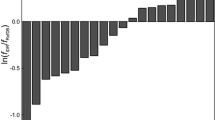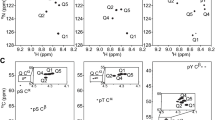Abstract
Secondary chemical shift analysis is the main NMR method for detection of transiently formed secondary structure in intrinsically disordered proteins. The quality of the secondary chemical shifts is dependent on an appropriate choice of random coil chemical shifts. We report random coil chemical shifts and sequence correction factors determined for a GGXGG peptide series following the approach of Schwarzinger et al. (J Am Chem Soc 123(13):2970–2978, 2001). The chemical shifts are determined at neutral pH in order to match the conditions of most studies of intrinsically disordered proteins. Temperature has a non-negligible effect on the 13C random coil chemical shifts, so temperature coefficients are reported for the random coil chemical shifts to allow extrapolation to other temperatures. The pH dependence of the histidine random coil chemical shifts is investigated in a titration series, which allows the accurate random coil chemical shifts to be obtained at any pH. By correcting the random coil chemical shifts for the effects of temperature and pH, systematic biases of the secondary chemical shifts are minimized, which will improve the reliability of detection of transient secondary structure in disordered proteins.







Similar content being viewed by others
References
Bienkiewicz EA, Lumb KJ (1999) Random-coil chemical shifts of phosphorylated amino acids. J Biomol NMR 15:203–206
Braun D, Wider G, Wuthrich K (1994) Sequence-corrected N-15 random coil chemical-shifts. J Am Chem Soc 116:8466–8469
Bundi A, Wuthrich K (1979) H-1-Nmr parameters of the common amino-acid residues measured in aqueous-solutions of the linear tetrapeptides H-Gly-Gly-X-L-Ala-Oh. Biopolymers 18:285–297
Dames SA, Aregger R, Vajpai N, Bernado P, Blackledge M, Grzesiek S (2006) Residual dipolar couplings in short peptides reveal systematic conformational preferences of individual amino acids. J Am Chem Soc 128:13508–13514
Dawson RMC, Elliot DC, Elliot WH, Jones KM (1986) Data for biochemical research, 3rd edn. Oxford University Press, Oxford
De Simone A, Cavalli A, Hsu ST, Vranken W, Vendruscolo M (2009) Accurate random coil chemical shifts from an analysis of loop regions in native states of proteins. J Am Chem Soc 131:16332–16333
Delaglio F, Grzesiek S, Vuister GW, Zhu G, Pfeifer J, Bax A (1995) Nmrpipe—a multidimensional spectral processing system based on Unix pipes. J Biomol NMR 6:277–293
Demarest SJ, Martinez-Yamout M, Chung J, Chen HW, Xu W, Dyson HJ, Evans RM, Wright PE (2002) Mutual synergistic folding in recruitment of CBP/p300 by p160 nuclear receptor coactivators. Nature 415:549–553
Dyson HJ, Wright PE (2002) Insights into the structure and dynamics of unfolded proteins from nuclear magnetic resonance. Adv Protein Chem 62:311–340
Dyson HJ, Wright PE (2005) Intrinsically unstructured proteins and their functions. Nat Rev Mol Cell Bio 6:197–208
Ebert MO, Bae SH, Dyson HJ, Wright PE (2008) NMR relaxation study of the complex formed between CBP and the activation domain of the nuclear hormone receptor coactivator ACTR. Biochemistry 47:1299–1308
Eliezer D, Jennings PA, Dyson HJ, Wright PE (1997) Populating the equilibrium molten globule state of apomyoglobin under conditions suitable for structural characterization by NMR. FEBS Lett 417:92–96
Geen H, Freeman R (1991) Band-selective radiofrequency pulses. J Magn Reson 93:93–141
Hsu ST, Bertoncini CW, Dobson CM (2009) Use of protonless NMR spectroscopy to alleviate the loss of information resulting from exchange-broadening. J Am Chem Soc 131:7222–7223
Jimenez MA, Nieto JL, Rico M, Santoro J, Herranz J, Bermejo FJ (1986) A study of the Nh Nmr signals of Gly-Gly-X-Ala tetrapeptides in H2O at low-temperature. J Mol Struct 143:435–438
Kay LE, Keifer P, Saarinen T (1992) Pure absorption gradient enhanced heteronuclear single quantum correlation spectroscopy with improved sensitivity. J Am Chem Soc 114:10663–10665
Kim HY, Heise H, Fernandez CO, Baldus M, Zweckstetter M (2007) Correlation of amyloid fibril beta-structure with the unfolded state of alpha-synuclein. Chembiochem 8:1671–1674
Kjaergaard M, Norholm AB, Hendus-Altenburger R, Pedersen SF, Poulsen FM, Kragelund BB (2010a) Temperature-dependent structural changes in intrinsically disordered proteins: formation of alpha-helices or loss of polyproline II? Protein Sci 19:1555–1564
Kjaergaard M, Teilum K, Poulsen FM (2010b) Conformational selection in the molten globule state of the nuclear coactivator binding domain of CBP. Proc Natl Acad Sci USA 107:12535–12540
Lam SL, Hsu VL (2003) NMR identification of left-handed polyproline type II helices. Biopolymers 69:270–281
MacArthur MW, Thornton JM (1991) Influence of proline residues on protein conformation. J Mol Biol 218:397–412
Merutka G, Dyson HJ, Wright PE (1995) ‘Random coil’ 1H chemical shifts obtained as a function of temperature and trifluoroethanol concentration for the peptide series GGXGG. J Biomol NMR 5:14–24
Modig K, Jurgensen VW, Lindorff-Larsen K, Fieber W, Bohr HG, Poulsen FM (2007) Detection of initiation sites in protein folding of the four helix bundle ACBP by chemical shift analysis. FEBS Lett 581:4965–4971
Mohan A, Oldfield CJ, Radivojac P, Vacic V, Cortese MS, Dunker AK, Uversky VN (2006) Analysis of molecular recognition features (MoRFs). J Mol Biol 362:1043–1059
Peti W, Smith LJ, Redfield C, Schwalbe H (2001) Chemical shifts in denatured proteins: resonance assignments for denatured ubiquitin and comparisons with other denatured proteins. J Biomol NMR 19:153–165
Plaxco KW, Morton CJ, Grimshaw SB, Jones JA, Pitkeathly M, Campbell ID, Dobson CM (1997) The effects of guanidine hydrochloride on the ‘random coil’ conformations and NMR chemical shifts of the peptide series GGXGG. J Biomol NMR 10:221–230
Ramboarina S, Redfield C (2003) Structural characterisation of the human alpha-lactalbumin molten globule at high temperature. J Mol Biol 330:1177–1188
Richarz R, Wuthrich K (1978) High-field 13C nuclear magnetic resonance studies at 90.5 MHz of the basic pancreatic trypsin inhibitor. Biochemistry 17:2263–2269
Schwarzinger S, Kroon GJ, Foss TR, Wright PE, Dyson HJ (2000) Random coil chemical shifts in acidic 8 M urea: implementation of random coil shift data in NMRView. J Biomol NMR 18:43–48
Schwarzinger S, Kroon GJ, Foss TR, Chung J, Wright PE, Dyson HJ (2001) Sequence-dependent correction of random coil NMR chemical shifts. J Am Chem Soc 123:2970–2978
Silver MS, Joseph RI, Hoult DI (1985) Selective spin inversion in nuclear magnetic resonance and coherent optics through an exact solution of the Bloch-Riccati equation. Phys Rev A 31:2753–2755
Spera S, Bax A (1991) Empirical correlation between protein backbone conformation and C.alpha. and C.beta. 13C nuclear magnetic resonance chemical shifts. J Am Chem Soc 113:5490–5492
Tamiola K, Acar Bi, Mulder FAA (2010) Sequence-specific random coil chemical shifts of intrinsically disordered proteins. J Am Chem Soc 132:18000–18003
Thanabal V, Omecinsky DO, Reily MD, Cody WL (1994) The C-13 chemical-shifts of amino-acids in aqueous-solution containing organic-solvents—application to the secondary structure characterization of peptides in aqueous trifluoroethanol solution. J Biomol NMR 4:47–59
Ting D, Wang G, Shapovalov M, Mitra R, Jordan MI, Dunbrack RL Jr (2010) Neighbor-dependent Ramachandran probability distributions of amino acids developed from a hierarchical Dirichlet process model. PLoS Comput Biol 6:e1000763
Uversky VN (2009) Intrinsically disordered proteins and their environment: effects of strong denaturants, temperature, pH, counter ions, membranes, binding partners, osmolytes, and macromolecular crowding. Protein J 28:305–325
Vranken WF, Boucher W, Stevens TJ, Fogh RH, Pajon A, Llinas P, Ulrich EL, Markley JL, Ionides J, Laue ED (2005) The CCPN data model for NMR spectroscopy: development of a software pipeline. Proteins 59:687–696
Wang Y, Jardetzky O (2002) Investigation of the neighboring residue effects on protein chemical shifts. J Am Chem Soc 124:14075–14084
Wang L, Eghbalnia HR, Markley JL (2007) Nearest-neighbor effects on backbone alpha and beta carbon chemical shifts in proteins. J Biomol NMR 39:247–257
Wishart DS, Sykes BD (1994) Chemical shifts as a tool for structure determination. Methods Enzymol 239:363–392
Wishart DS, Sykes BD, Richards FM (1991) Relationship between nuclear magnetic resonance chemical shift and protein secondary structure. J Mol Biol 222:311–333
Wishart DS, Sykes BD, Richards FM (1992) The chemical shift index: a fast and simple method for the assignment of protein secondary structure through NMR spectroscopy. Biochemistry 31:1647–1651
Wishart DS, Bigam CG, Holm A, Hodges RS, Sykes BD (1995a) 1H, 13C and 15 N random coil NMR chemical shifts of the common amino acids. I. Investigations of nearest-neighbor effects. J Biomol NMR 5:67–81
Wishart DS, Bigam CG, Yao J, Abildgaard F, Dyson HJ, Oldfield E, Markley JL, Sykes BD (1995b) 1H, 13C and 15 N chemical shift referencing in biomolecular NMR. J Biomol NMR 6:135–140
Wu KP, Kim S, Fela DA, Baum J (2008) Characterization of conformational and dynamic properties of natively unfolded human and mouse alpha-synuclein ensembles by NMR: implication for aggregation. J Mol Biol 378:1104–1115
Zhang H, Neal S, Wishart DS (2003) RefDB: a database of uniformly referenced protein chemical shifts. J Biomol NMR 25:173–195
Acknowledgments
This work was supported by the EliteForsk programme (M.K.), The John and Birthe Meyer Foundation, the Carlsberg Foundation grant number 2008-01-0368 and The Danish Natural Research Council grant numbers 272-08-0500 (F.M.P). We thank Kamil Tamiola and Frans Mulder (University of Groningen) for sharing their data for comparison of the random coil data sets and Gitte Wolfsberg Haxholm and Birthe B. Kragelund for valuable discussions and critical comments to the manuscript.
Author information
Authors and Affiliations
Corresponding author
Rights and permissions
About this article
Cite this article
Kjaergaard, M., Brander, S. & Poulsen, F.M. Random coil chemical shift for intrinsically disordered proteins: effects of temperature and pH. J Biomol NMR 49, 139–149 (2011). https://doi.org/10.1007/s10858-011-9472-x
Received:
Accepted:
Published:
Issue Date:
DOI: https://doi.org/10.1007/s10858-011-9472-x




